 |
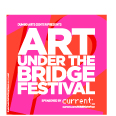 |
||||
|
|
|
|
|
|
|

Expert | Jean-Luc Vilmouth | 2007 | 6:30 min.
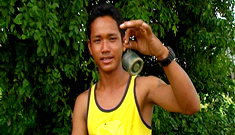
Jean-Luc Vilmouth is born in Creutzwald (Moselle) in 1952. He lives and works in Paris. Vilmouth has exhibited in galleries, museums, biennials and festivals internationally and is represnetd by Aline Vidal, Paris. Very early on, Vilmouth has been interested in issues relating to the origins of objects and, subsequently, in our relationship to the environment. In his work, an object in the source of an investigation of the human social construction: the artist explores the processes that generate meaning and value by establishing links –either formal or historical – between the various constituents of our everyday life. The “formal” reference may be borrowing from the ready-made. This is, however, the limit of the similarity that may exist between the work of Duchamp and that of Vilmouth. In a like manner, one could see references to minimal and conceptual art ; however, these might more be the result of a certain way of establishing new meaning with familiar references, and that is precisely the focus of Vilmouth’s work. In proposing other types of links between objects and context, he offers a different viewpoint on the relationship the “viewer” maintains with the objects on display.[...] (Benjamin Weil)
Dirty Pictures | John Smith | 2007 | 14:00 min.
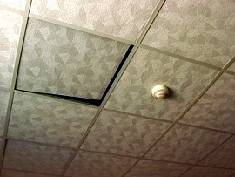
John Smith was born in London in 1952 and studied film at the Royal College of Art. Since 1972 he has made over 40 film, video and installations works. His films have been shown in cinemas, art galleries and on television throughout the world and awarded major prizes at film festivals in Leipzig, Oberhausen, Hamburg, Cork, Geneva, Palermo, Graz, Uppsala, Bangkok, Ann Arbor and Chicago. One-person presentations of his work include exhibitions at Ikon Gallery (Birmingham), Pearl Gallery (London), Open Eye Gallery (Liverpool), Kunstmuseum Magdeburg (Germany) and retrospectives at the Venice Biennale and Oberhausen, Cork, Tampere, Uppsala, Regensburg and Winterthur international film festivals. John Smith is Professor of Fine Art at the University of East London.
Untitled | Kendel Bennett | 2008 | 5:00 min.
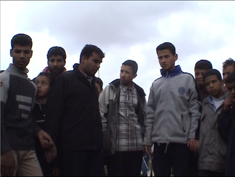
Leighton Pierce uses film, video, and sound to create experiences in transformative time. He creates multi-channel site-specific installations as well as single channel works. His award-winning short films and videos have been exhibited in major art museums and film festivals throughout the world including The Whitney Biennial , The San Francisco, New York, and Rotterdam Film Festivals. He has had retrospectives at The Lincoln Center, The Cinémathèque française, Festival Nemo, and Pompidou Center in Paris, and at The Lisboa Bienal of Contemporary Art. Most recently, Pierce has been working with video installations that have been shown at The Exploratorium in San Francisco, Museé d’art contemporaine in Montréal, and at Boudin College Art Museum. A major 13 channel, 5500 sq. ft. video installation, Warm Occlusion, was presented in 2006 at the University of Iowa Museum of Art. Pierce has received fellowships from the Rockefeller Foundation, The Guggenheim Foundation, the National Endowment for the Arts, and The Camargo Foundation.
Acknowledgment #2 | Einat Amir | 2007 | 2:41 min.
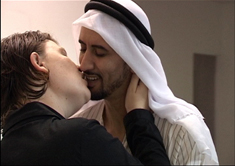
The lengthy kiss is photographed in cyclical motion, like a quote from a romantic film, yet displaying difficulty and distress. As the kiss drags on, it becomes more and more disturbing to watch. This work deals with the Israeli – Palestinian conflict in a very personal way, ends up leaving the viewer confused and with contradictory feelings.
Einat Amir was born in 1979 in Jerusalem, Israel. In 2004 she graduated from The Midrasha School of Art in Israel, where she was the recipient of several grants and a full fellowship from the Ministry of Education. She has exhibited her work widely in Museums and galleries in Israel, as well as in New York and London. She currently lives in New York, and will earn her MFA degree from Columbia University in 2009. She works primarily in video and engages with political questions of our day regarding sexuality and post colonialism. Despite the seriousness of these questions, her work often displays a humorous methodology. Einat had also curated several shows and edited an Israeli Magazine regarding feminism in Israeli art.
It is springtime and I am still living in Cyprus | Lia Lapithi | 2008 | 2:00 min.
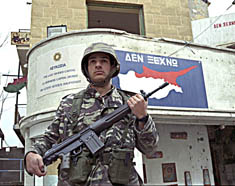
Lia LAPITHI Works in multi-media installations/video/photography in Nicosia, Cyprus www.lialapithi.com BA Art and Environmental Design UCSC, California, USA Mphil Art Lancaster University, UK Diploma of Architecture Canterbury Institute of Art and Design.
Recipe for marinated crushed olives | Lia Lapithi Shukuroglou | 2006 | 3:00 min.
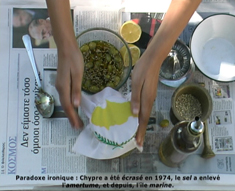
a) The European parliament has obliterated the Cyprus problem, the Cyprus problem is not a priority,
b) We are not as similar as we think…
Lia LAPITHI Works in multi-media installations/video/photography in Nicosia, Cyprus www.lialapithi.com BA Art and Environmental Design UCSC, California, USA Mphil Art Lancaster University, UK Diploma of Architecture Canterbury Institute of Art and Design.
Electricity | Lia Lapithi Shukuroglou | 2006 | 2:30 min.
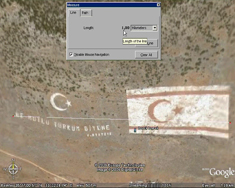
Lia LAPITHI Works in multi-media installations/video/photography in Nicosia, Cyprus www.lialapithi.com BA Art and Environmental Design UCSC, California, USA Mphil Art Lancaster University, UK Diploma of Architecture Canterbury Institute of Art and Design.
Horizon | Jesal Kapadia | 2006 | 2:30 min.
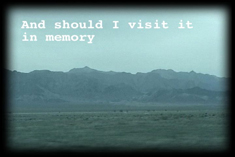
You ask me about that country, whose details now escape me,
I don’t remember its geography, nothing of its history.
And should I visit it in memory,
It would be as I would a past lover,
After years, for a night, no longer restless with passion,
with no fear of regret.
I have reached that age when one visits the heart merely as a courtesy.
Faiz Ahmed Faiz (Pakistani poet, born in India in 1911, d. 1984)
Straight Stories - Part 1 | Bouchra Khalili | 2007 | 10:00 min.
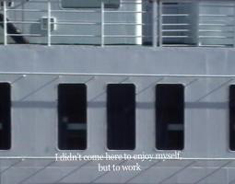
Bouchra Khalili (Morocco, 1975) is a video artist and photographer graduated from the École Nationale Supérieure d'Arts de Paris-Cergy. Exhibited her works in the La Vitrine gallery in Paris. In 2000, was invited by the Palais de Tokyo to produce the video “L'antichambre” (The Hall), exhibited in Paris and on the Palais de Tokyo website. At the end of 2002, there was an exhibition of her works “Appuntamento” (Appointment) and “A Rebours” (Back to Front). As a videomaker, she took part in Meetings Video/Plastic Art of Herouville, Meetings Paris/Berlin (2003); and in the Nights of the Shorts Seville, Spain, among others. She has also published texts in collective books. She currently lives in Paris where she studies Film at the Sorbonne Nouvelle and teaches Film History.
Borderline Disorder [1 to 6] | Gabriela Monroy | 2008 | 10:00 min.
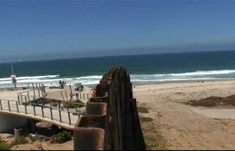
Gabriela Monroy is a Mexican videoartist and video curator living and working in New York and Mexico City. In 2001 she received a Masters in Film and Video from the School of Art Institute of Chicago. In 2001 she was awarded the National Foundation for Culture and Art Fellowship for Young Emerging Artists. In 2002 she was selected with a four channel video installation, as part of the 10th National Biennal of Photography of Mexico. She continues working with interactive video installations as well as live video under the name MOSTRA in collaboration with Caspar Stracke since 2002. In 2004 they were awarded a NYSCA Film and Media Production Grant for the production of an Interactive video installation for cinema space. She has participated in exhibitions in Mexico, Europe, Korea and the US.